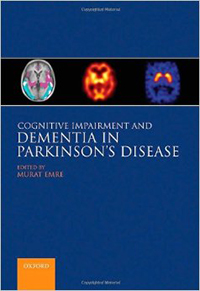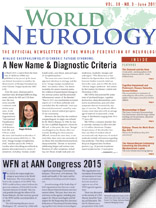 The medical book publishing industry is challenged nowadays to turn out products quickly and efficiently, lest the rapid dissemination of today’s scientific advances through the Internet render the content of a book out of date on arrival. The second edition of Murat Emre’s “Cognitive Impairment and Dementia in Parkinson’s Disease” has avoided this fate, in large part because of the organizational skill of the editor and his recruitment of the same authoritative thought leaders that contributed to the first edition in 2010. Hence, this continuity of authorship has allowed for a seamless update of the topics covered before.
The medical book publishing industry is challenged nowadays to turn out products quickly and efficiently, lest the rapid dissemination of today’s scientific advances through the Internet render the content of a book out of date on arrival. The second edition of Murat Emre’s “Cognitive Impairment and Dementia in Parkinson’s Disease” has avoided this fate, in large part because of the organizational skill of the editor and his recruitment of the same authoritative thought leaders that contributed to the first edition in 2010. Hence, this continuity of authorship has allowed for a seamless update of the topics covered before.
The co-authors of each of the 22 well- written chapters have handled their assignments with balanced attention to recent discoveries and to the potential for practical application. There is also a healthy regard for the concept that all roads of investigation ultimately lead back to the patient, whose struggle to cope with the twin burdens of progressive motor and cognitive impairment in Parkinson’s disease (PD) has not been significantly helped by a true breakthrough in treatment since the introduction of levodopa in the 1960s. The failure to develop more effective symptomatic or game-changing, disease-modifying therapies has been one of the great disappointments of modern-day clinical research despite years of valiant effort.
 As Dr. Emre observes in his elegant introduction, cognitive impairment as an essential feature of PD was mostly unrecognized by James Parkinson in his essay on the Shaking Palsy (1817) because lack of treatment doomed its victims to a severe physical disability and a shortened lifespan. The stark reality of cognitive impairment in advanced PD became apparent only after the remarkable benefit of levodopa enabled people with PD to function better physically and thereby live longer. Well-designed, long-term cohort studies in the early part of this century revealed not only the shocking news that 70-80 percent of people with PD would develop dementia as they aged and progressed, but also that subtle cognitive abnormalities, particularly in executive function, were prevalent in a sizeable minority at early stages of the disease.
As Dr. Emre observes in his elegant introduction, cognitive impairment as an essential feature of PD was mostly unrecognized by James Parkinson in his essay on the Shaking Palsy (1817) because lack of treatment doomed its victims to a severe physical disability and a shortened lifespan. The stark reality of cognitive impairment in advanced PD became apparent only after the remarkable benefit of levodopa enabled people with PD to function better physically and thereby live longer. Well-designed, long-term cohort studies in the early part of this century revealed not only the shocking news that 70-80 percent of people with PD would develop dementia as they aged and progressed, but also that subtle cognitive abnormalities, particularly in executive function, were prevalent in a sizeable minority at early stages of the disease.
This book thoughtfully reviews the important developments in clinical and basic research of the last two decades, and it highlights new and refined information that has emerged in the five years since the first edition was published. References are up to date as of 2013 with a sprinkling of 2014, the year of publication. Early chapters on epidemiology, natural clinical history and neuropsychological assessment are comprehensive and succinct. The differential diagnosis of dementia in the setting of parkinsonism can be difficult, but the neuropsychological profile of cognitive dysfunction in PD, showing the typical executive, visuo-spatial, attention and memory deficits of PD sets it apart generally from Alzheimer’s disease, wherein disturbances of memory and language are the classic hallmark findings.
The histopathology of PD is the focus of several chapters, which emphasize the near unanimity of opinion that misfolded alpha-synuclein is the key molecular abnormality and the main component of the signature intracytoplasmic inclusion Lewy body. The clinical and pathological continuum of Parkinson’s disease dementia (PDD) and dementia with Lewy bodies (DLB) is also effectively explained, including elements of the debate over the contribution of the plaques and tangles of Alzheimer disease (AD) as a minority component of PDD/DLB pathology. Current evidence suggests (without being close to consensus) that DLB, which is defined arbitrarily as dementia occurring within a year of the onset of parkinsonism, has a pathological substrate of alpha-synuclein and Alzheimer plaque (sans tangles), whereas the substrate for PDD — dementia beginning more than a year after the onset of parkinsonism — is more likely to be alpha-synclein alone. Another chapter covers the neurochemistry of PD and PDD and the central relevance of the well-known deficiencies of dopamine and acetylcholine as they relate to the evolution of dementia.
The ferment in biomarker research — a relatively new phenomenon with great promise for predicting cognitive outcomes in the preclinical and early clinical stages of PD and for identifying subgroups for targeting in clinical trials of new therapies — is included in several chapters. Also since the first edition, official criteria for Parkinson dementia and mild cognitive impairment (MCI) in PD have been established under the auspices of the International Parkinson and Movement Disorder Society, using the model of the Petersen criteria for pre-Alzheimer MCI. Several chapters on recent findings in brain imaging are well executed, although it could be argued that all imaging should have been condensed into a single chapter. One of the hottest areas of research in the basic science of PD is the rapidly expanding field of Parkinson genetics. The chapter on the genetic basis of PDD is excellent and comprehensive.
Ian McKieth and Murat Emre join forces in the pentultimate chapter to discuss management of PDD and DLB, and the result is a masterful presentation of a humane message about the time-honored clinical fundamentals of taking a good history, listening empathically and caring long term for the patient and family.
Finally, the closing brief chapter by John Hardy is a sobering statement of how far we still must go before truly meaningful treatment comes into view. He acknowledges the substantial “incremental” progress in molecular biology and genetics of the last decade. The identification of numerous potentially causative somatic and mitochondrial genetic loci in some patients clears some of the fog around pathogenesis, although these advances apply only to a small fraction of the much larger universe of patients with PD, for whom genetic markers are nowhere to be found. Moreover, it is far from clear which pathogenetic pathways are influenced by alterations in the genome or, perhaps more important, how the growing number of these changes interact to produce disease and which ones are the most critical in the pathogenetic cascade. In short, the goal of a cure is “still beyond the near horizon.”
“Cognitive Impairment and Dementia in Parkinson’s Disease” is a solid achievement. The authors have created an informative and useful compendium of the universally accepted wisdom as well as the latest more controversial advances in the field. It is easy for an armchair reviewer to find fault with even the best publications, but there are a few minor shortcomings here. First, the list of contributors should have included the specific disciplines of each person in addition to their institutional affiliations. Second, some of the references at the end of each chapter were duplicated or unrelated to the citations in the text. Third, redundancy across chapters was generally appropriate for emphasis of the most important concepts and facts, but more careful editing could have minimized useless redundancy. Fourth, the importance of impaired olfaction in preclinical PD and the voluminous body of research devoted to it was all but ignored; olfaction received only a brief paragraph in one of the early chapters and no attention was paid in the chapter on biomarkers. And fifth, there was no mention of the so-called “prion hypothesis” that has been invoked in the last several years to explain how alpha-synuclein pathology spreads rostro-caudally throughout the brain as the disease progresses and leads to the development of dementia. These small quibbles hardly detract from the many assets of this fine contribution to the growing shelf of literature on one of the most pressing problems in clinical neurology.
